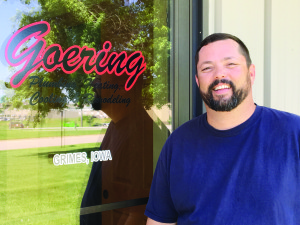5 ways to protect your employees and your business
 Business owners are required by law to provide a safe work environment for their employees and to give them the necessary training required by the Occupational Safety and Health Administration (OSHA), a subset of the U.S. Department of Labor responsible for assuring safe and healthy working conditions by setting and enforcing standards and providing resources, training and other assistance.
Business owners are required by law to provide a safe work environment for their employees and to give them the necessary training required by the Occupational Safety and Health Administration (OSHA), a subset of the U.S. Department of Labor responsible for assuring safe and healthy working conditions by setting and enforcing standards and providing resources, training and other assistance.
Safety on the worksite should be a top priority for business owners, big and small, says Jens Nissen, OSHA administrator for the state of Iowa. However, it’s something smaller businesses struggle with and are more likely to have violations of as a result.
“It’s hard for the small employers to deal with the safety and health in the workforce because they don’t have a specific person designated to this,” he says. “They’re focused on getting the job done and being successful in that regard, but I would say not to separate safety from that aspect of their business. One is a big part of the other and inextricably bound.”
Small business owners can do several things to ensure that they provide a safe workplace and to protect themselves in case of an employee injury and a resulting workers’ compensation claim.
1. Know obligations, requirements under law
The Department of Labor details the requirements of a safe workplace on its website (www.dol.gov). These include:
• Providing a workplace free from serious recognized hazards that complies with OSHA standards, rules and regulations.
• Ensuring employees have and use safe tools and equipment that is properly maintained.
• Using color codes, posters, labels and/or signs to warn employees of potential hazards.
• Providing safety training in a language and with vocabulary workers can understand, as well as medical examinations as required.
• Creating hazardous chemical plans and providing copies to employees.
• Reporting to the nearest OSHA office within a designated time period all work-related fatalities, inpatient hospitalizations, amputations and losses of an eye.
• Keeping records of work-related injuries and illnesses.
• Correcting cited violations by the deadline set in the OSHA citation and submitting verification of correction.
More information is available on the OSHA website: www.osha.gov.
Every business owner, regardless of the number of employees, needs to know and understand OSHA guidelines because most are subject to all aspects of the rules, Nissen says.
The state’s OSHA department has 21 inspectors who are continuously monitoring job sites to ensure worker safety.
Requirements can differ for the industry in which one works, which is why Nissen says business owners should review the federal and state OSHA standards in their entirety.
Many times, safety on the job site comes down to common sense.
“If something doesn’t look right, it probably isn’t,” Nissen says. “You don’t want to overcomplicate things.”
For example, machinery should be guarded in a way that a passer-by cannot be harmed. If an employee is working on an elevated surface, the company needs to ensure that person has fall protection. Plumbers or other workers doing excavation work need to have a protective structure set up in case of a cave-in.
Kevin Goering, the third-generation owner of his family’s plumbing, heating, cooling and remodeling business in Grimes, says the biggest challenge business owners face when it comes to safety is ensuring their employees are trained properly. Once the employees are trained, the next challenge is to ensure that they follow through with safety protocols.
“You can tell them 100 times how to use a ladder or shore a ditch, but they might not listen, and, ultimately, I’m the one responsible,” he says. “It’s worth the five minutes to do it right than put your life in danger.”
Goering’s employees also take required OSHA training and continuing education to keep current with state licenses. Most of his company’s work is residential, so he says his employees have less exposure to hazards such as falls from scaffolding.
The company did have a situation in the early 2000s in which an employee almost died because he did not shore a ditch that he was digging at a job site. The employee was asked via radio whether he had shored the ditch and said “no” but proceeded to climb in, where he was buried alive.
Cave-ins and ladder safety are two of the biggest hazards that Goering’s 14 employees face on the job and are the areas in which they receive the most training. Employees are also educated about proper safety for soldering and exposure to chemicals that are used to glue together pipes.
“We constantly remind people of safety precautions,” Goering says.
Dave Voyna, owner of Ultimate Lawn Services L.L.C. in Grimes, has done more training than he’s been required during his 14 years of operating his business. He also keeps up to date on safety information through blogs, newsletters and other online sources.
Voyna provides his 20 employees with safety information he reads. From one newsletter, he prints pictures of situations where there are safety issues shown.
“I’ll see if the guys can get the correct number that are wrong and point to them and say what they’re doing wrong and how to do it correctly,” he says.
Voyna makes sure to educate his employees on the biggest risks in their industry, specifically the correct way to mow on a hill, to shoot or blow away grass clippings from vehicles, to wear safety vests and to be aware of their surroundings.
“If somebody is around you, you need to stop,” he says. “If you’re mowing and someone is walking on a sidewalk, make sure you stop what you’re doing and wait until they pass.”
Voyna also follows regulations when it comes to use of pesticides and other chemicals for his lawn care business. He keeps spray log books and records wind speed, temperature and the time in which a particular chemical was sprayed. Lawns and areas that are treated must be flagged to warn passers-by of the use of pesticides or other chemicals.
Voyna’s company has had one safety issue: An employee drove a mower onto a retaining wall while trying to mow on a hill. The mower became stuck, but no one was hurt.
2. Seek outside help to ensure hazards are mitigated
A second set of eyes from an expert can be a good thing when ensuring a worksite is safe and free of hazards for employees.
Nissen says anyone with questions regarding OSHA regulations can contact his office or the separate Iowa OSHA Consultation and Education bureau.
Business owners who have fewer than 250 employees on site or 500 company-wide are eligible for Iowa OSHA’s on-site consultation services, which help employers identify safety and health hazards in the workplace.

These services are free, confidential and separate from Iowa OSHA enforcement. The consultation will point out hazards; provide a review of written safety and health programs, and injury and illness recordkeeping; provide industrial hygiene services such as monitoring exposures to fumes, dusts, chemicals and noise; and evaluate engineering controls.
The employer will not receive a citation or penalty for any safety and health hazards discovered but agrees to correct the issue within a set timeframe, says Joe Mullen, bureau chief for Iowa OSHA Consultation and Education.
During the consultation, an OSHA consultant also will explain the rights and responsibilities the employer has for hazard identification and other OSHA regulations. Then the consultant will conduct a walk-through of the workplace to identify hazards that may also be violations standards. If any serious hazards are found, a closing conference will be held in which the hazards are discussed with an agreed amount of time for correction.
“We’re trying to evaluate their health and safety management programs, which is a system that assists companies in identifying and correcting hazards through hazard recognition and correction, accountability, responsibilities and training,” Mullen says.
Free consultation services are available once a year or every two years. Mullen says the service is one that small business employers should take advantage of to ensure they have appropriate health and safety plans in place.
Iowa OSHA’s Consultation and Education office also provides hazard awareness training for small businesses and has a video loan library that contains videos on various health and safety topics that businesses can borrow for free to provide additional information to their employees.
Nissen also suggests businesses contact their insurance carrier or trade association for additional resources.
3. Ensure employees receive training to keep themselves safe
Many trades require a certain number of OSHA safety training during apprenticeships and continuing education in order for craftsmen and women to keep their licenses.
For example, all electricians take OSHA safety training during their four years of apprenticeship school. Licensed journeymen electricians take 18 hours of continuing education every three years in order to keep their electrical license. Six hours of this training is about the electrical code and 12 hours is safety driven on topics such as general electrical safety and arc flash training.

At some job sites, there may be weekly safety meetings with general contractors to inform all workers of potential hazards on the site. Workers including electricians, plumbers and other trades may be required to wear high visibility vests and hard hats to ensure safety.
For example, there may be times when an electrician may be working in a finished office space with no work being performed overhead. The contractor for the site may still require that person to wear a hardhat at all times.
Electricians also have specific safety apparatus they are required to use per the electrical industry. This includes arc flash suits and rubber blankets to insulate areas with live electricity. Another big concern in the electrical industry are falls, which are deadlier than being electrocuted. Each job site will have fall safety apparatus in place with railings and other security.
Worker injuries are most times dependent upon the industry in which the employee works. However, some could be mitigated if employers conduct ergonomic assessments for employees and ensure overall that the workplace is free of tripping hazards such as loose carpeting or open drawers or cabinets, as well as items on which employees could slip and fall such as wet floors or ice or snow in the parking lot, legal experts say.
The company’s worker’s compensation insurance agent will likely have a list of common injuries or workplace hazards that employers could utilize to help avoid those types of injuries.
“The most important thing employers can do is to check the workplace for common things that might cause somebody to slip or trip and injure themselves,” says Nicholas Platt, a work injury attorney for Platt Law Firm PC. in Urbandale.
4. Protect interests with insurance, know signs of fraud
According to the Labor Department, an effective safety and health program can save a business $4 to $6 for every $1 invested because paying for an accident or injury through a workers’ compensation claim or sick days can be more expensive than taking safety measures.
Business owners can also protect their company and employees by carrying workers’ compensation insurance. This insurance will cover an employee’s wages and medical-related expenses — rules can vary by state — in cases of on-the-job injury or illness.
In Iowa, the Workers’ Compensation Act is part of the Iowa Code. It allows for certain benefits to be provided to employees who are injured, or receive occupational disease or hearing loss during or as a result of their employment. The benefits are payable regardless of fault.

Employers need to be mindful that cases of worker’s compensation fraud do exist, according to EMPLOYERS, a group of companies that provides workers’ compensation insurance and services to small businesses.
Business owners need to take the following into consideration when a claim is file, according to the group:
• Was the injury or illness reported in a timely manner?
• Does the employee have a history of claims?
• Were there witnesses to the incident?
• Does the incident coincide with any change in employment status?
• When was the injury reported — first thing on a Monday or late on Friday but not reported until Monday can be questionable.
• Does the employee’s description of what happened conflict with the medical history or injury report?
• Did the employee refuse treatment?
Workers’ compensation insurance costs can be minimized by making safety a priority and discussing it regularly with employees, according to Entrepreneur magazine. This includes sharing injury information with workers and explaining the cost to the company as a result.
Business owners and managers also should examine any trends in workplace injuries to address the causes, and utilize workers’ compensation safety programs whether through a government office or online resources, according to Entrepreneur.
5. Make a health, safety plan; take immediate action if an injury, violation occur
OSHA officials say businesses should put health and safety plans and policies in writing. Larger companies may have a designated person on the payroll who handles these types of issues.
Even if the company does not have a point person, the manager or owner still needs to take immediate action if an employee is injured on the job site.
When Goering’s company was larger and employed up to about 75 people, there was a dedicated employee devoted to safety issues. Now, Goering oversees safety training.
Action should take place right away, says Platt, the work injury attorney. A delay could make it take longer for the employee to recover from injury, he adds.
“Make sure if or when an employee talks about an injury or reports an injury that action is taken quickly, and that it’s not ignored,” he says. “The sooner it is addressed the severity can be lessened and the process shorter for the employee and the employer.” ♦


superbeets review
Thanks for sharing your thoughts on %meta_keyword%. Regards|